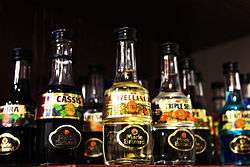Anisette

Anisette, or Anis, is an anise-flavored liqueur that is consumed in most Mediterranean countries, mainly in Spain, Italy, Portugal, Turkey, Greece, Lebanon, Cyprus, Israel, and France. It is colorless, and because it contains sugar, is sweeter than dry anise flavoured spirits (e.g. absinthe). The most traditional style of anisette is that produced by means of distilling aniseed,[1] and is differentiated from those produced by simple maceration by the inclusion of the word distilled on the label. And while Pastis is a similar-tasting liqueur that is prepared in similar fashion and sometimes confused with anisette, it employs a combination of both aniseed and licorice root extracts. Sambuca is essentially an anisette of Italian origin that requires a high minimum (350g/l) sugar content.[2]
The liqueur is not commonly taken straight on account of its strong flavour. When included in mixed drinks however, it produces a sweet agreeable flavour. It is often mixed simply with water, where it produces a milky white consistency. That mixture is called in Spanish speaking countries "palomita". All the liqueur has to be dropped into very cold water at the same moment. Pouring it from a bottle even quickly does not produce the same result. A very white liquid denotes that a good anisette has been used. A "palomita" with just a drop of anisette can be drunk as a refreshing drink.
Names and brands of anisette
In Spanish-speaking regions
- Anís del Mono ("the monkey's anisette") is a popular anís made in Spain and has been produced since 1870.[3] The label, with a monkey holding a scroll and a bottle, was designed by Ramon Casas i Carbó.[4] It is the anisette of choice in Ernest Hemingway's The Sun Also Rises[5] and Malcolm Lowry's Under the Volcano.[6]
- Anís Najar is a brand produced in Arequipa (Peru) since 1854, with a very high alcohol content (46.2º GL).
- Chinchón is the name of a town identified with "anís" beverages. The different producers joined in "Alcoholera Española. S. A." It produces different kinds of anise beverages. Anisette is called simply "Chinchón dulce", i. e. "sweet Chinchón".
- Ojén (or Aguardiente de Ojén (es), or simply "ojen", "OH-hen", as it is known in English) is another name of a Spanish town identified with an "anís" beverage. This liqueur, nowadays locally produced by the distillery company Dominique Mertens Impex. S.L.,[7] gained widespread fame abroad and is very popular in the city of New Orleans, Louisiana, especially during the Mardi Gras festivities.[8]
- Aguardiente flavored with anise is sold in Colombia, Mexico, and elsewhere.[9]
- Cartujo is one of the most widely known brands in Latin America. It is made in Venezuela and is usually mixed with juices, yogurt, or simply water. It contains 30% ABV.
- Anís Gorila was produced in Puerto Rico since at least 1935 but a similar anis called Anissett Gorila is made in Curaçao by Leáñez & Cia.
- Anís 8 Hermanos is produced in Argentina.
Outside Spanish-speaking regions
While anisette is most popular in Mediterranean countries, it is widely known in English-speaking countries as well. Characters in Ernest Hemingway's novel The Sun Also Rises and his short story "Hills Like White Elephants" drink and discuss Anís del Toro – "Bull's Anisette."
In other countries, particularly those in the Mediterranean Basin, anise-based or liquorice-based spirits are traditionally consumed, including:
- France: Pastis and Anisette

- Italy: Sambuca, liquore all'anice, anisetta, mistra'. Varnelli, liquore all'anice prodotto nelle Marche
- Greece: Ouzo
- Bulgaria and Macedonia: Mastika
- Turkey, Azerbaijan, and Albania: Rakı
- Lebanon, Syria, Israel, Jordan, and Egypt: Arak
- Japan: Alaki
Notes and references
- ↑ Blue, Anthony (2004). The Complete Book of Spirits. New York: HarperCollins. p. 283. ISBN 0-06-054218-7.
- ↑ "REGULATION (EC) No 110/2008 OF THE EUROPEAN PARLIAMENT AND OF THE COUNCIL of 15 January 2008 on the definition, description, presentation, labelling and the protection of geographical indications of spirit drinks and repealing Council Regulation (EEC) No 1576/89". Official Journal of the European Union. European Union. Retrieved 28 October 2016.
- ↑ Zurdo, David; Gutiérrez, Ángel (2004). El libro de los licores de España. Ediciones Robinbook. p. 50. ISBN 9788496054127. Retrieved 5 February 2013.
- ↑ Eaude, Michael (2007). Catalonia: A Cultural History. Oxford UP. p. 113. ISBN 9780199886883. Retrieved 5 February 2013.
- ↑ Hemingway, Ernest (2006). The Sun Also Rises. Simon and Schuster. p. 162. ISBN 9780743297332. Retrieved 5 February 2013.
- ↑ Lowry, Malcolm (2012). Under the Volcano: A Novel. Open Road Media. p. 24. ISBN 9781453286296. Retrieved 5 February 2013.
- ↑ Dominique Mertens Impex. S.L., Ojén, aguardiente superior, official website, in Spanish
- ↑ New Orleans Nostalgia, "Banana Republics and Ojen Cocktails", Ned Hémard, 2007
- ↑ Franz, Carl; Havens, Lorena (2006). The People's Guide to Mexico. Avalon Travel. p. 96. ISBN 9781566917117. Retrieved 15 February 2013.